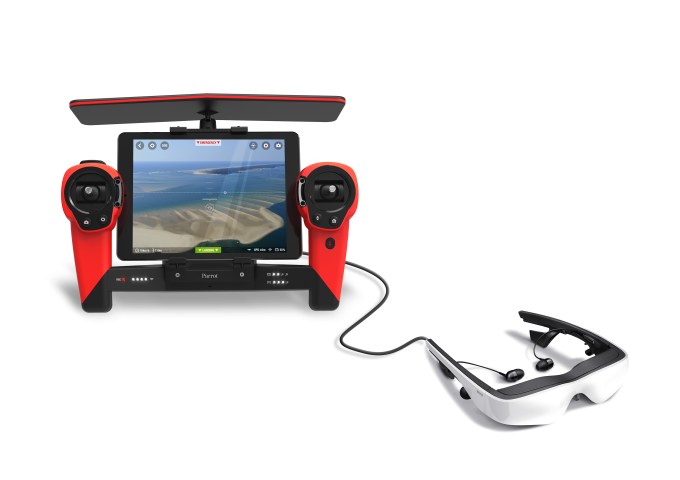Parrot just dropped the price of high-definition drones. The firm’s Bebop drone will hit stores next month with a starting price of $500. That’s several hundred less than DJI’s entry-level Phantom drone even though it packs the same quality camera and several novel tricks including being controllable from a smartphone or tablet..
The Bebop is a big upgrade from the cheaper AR Drone, which, in part, helped install drones in the public’s mindset. Like with the AR Drone before it, Parrot equipped serious drone technology in the Bebop yet managed to keep the price down and safe to fly indoors.
Compared to the similar DJI Phantom, the Bebop packs a lot of the same flight capabilities. And with the more expensive range extender controller, the Bebop has about the same range, too, with a 2 kilometer limit. The drone is capable of streaming the captured video back to a smartphone and it uses built-in GPS and downward facing cameras to help keep the drone in place during high-altitude flying.
The Bebop relies on a software-based 3-axis image stabilization to keep the image fixed and without distortion. Parrot explains the system take the image captured by the 14MP camera and cuts out the stable part, throwing away the bits on the edge that show the drone’s movement. This allows for the camera to be packed into the Bebop’s sleek body rather than dangling underneath.

Parrot also developed a dedicated controller for the Bebop that extends the Bebop’s range from 200 meets to 2 kilometers and allows for the pilot to view the drone’s camera output in AR glasses including the Oculus Rift. The controller amplifies the connected smartphone or tablet’s wifi signal and provides analog joysticks and buttons for more precise control. But this extra fun comes at a price: A Bebop with the SkyController costs $900.
Both the standard and SkyController editions will hit Best Buy and Apple stores in December for $500 and $900, respectively.
The Bebop is a big upgrade from the cheaper AR Drone, which, in part, helped install drones in the public’s mindset. Like with the AR Drone before it, Parrot equipped serious drone technology in the Bebop yet managed to keep the price down and safe to fly indoors.
Compared to the similar DJI Phantom, the Bebop packs a lot of the same flight capabilities. And with the more expensive range extender controller, the Bebop has about the same range, too, with a 2 kilometer limit. The drone is capable of streaming the captured video back to a smartphone and it uses built-in GPS and downward facing cameras to help keep the drone in place during high-altitude flying.
The Bebop relies on a software-based 3-axis image stabilization to keep the image fixed and without distortion. Parrot explains the system take the image captured by the 14MP camera and cuts out the stable part, throwing away the bits on the edge that show the drone’s movement. This allows for the camera to be packed into the Bebop’s sleek body rather than dangling underneath.

Parrot also developed a dedicated controller for the Bebop that extends the Bebop’s range from 200 meets to 2 kilometers and allows for the pilot to view the drone’s camera output in AR glasses including the Oculus Rift. The controller amplifies the connected smartphone or tablet’s wifi signal and provides analog joysticks and buttons for more precise control. But this extra fun comes at a price: A Bebop with the SkyController costs $900.
Both the standard and SkyController editions will hit Best Buy and Apple stores in December for $500 and $900, respectively.